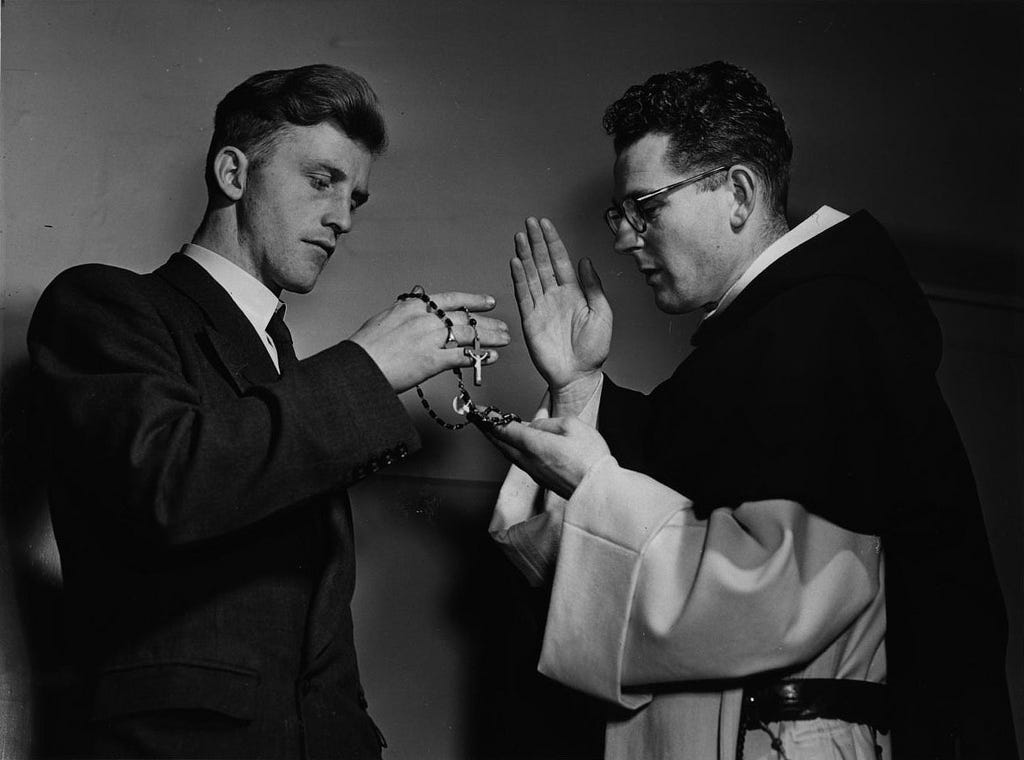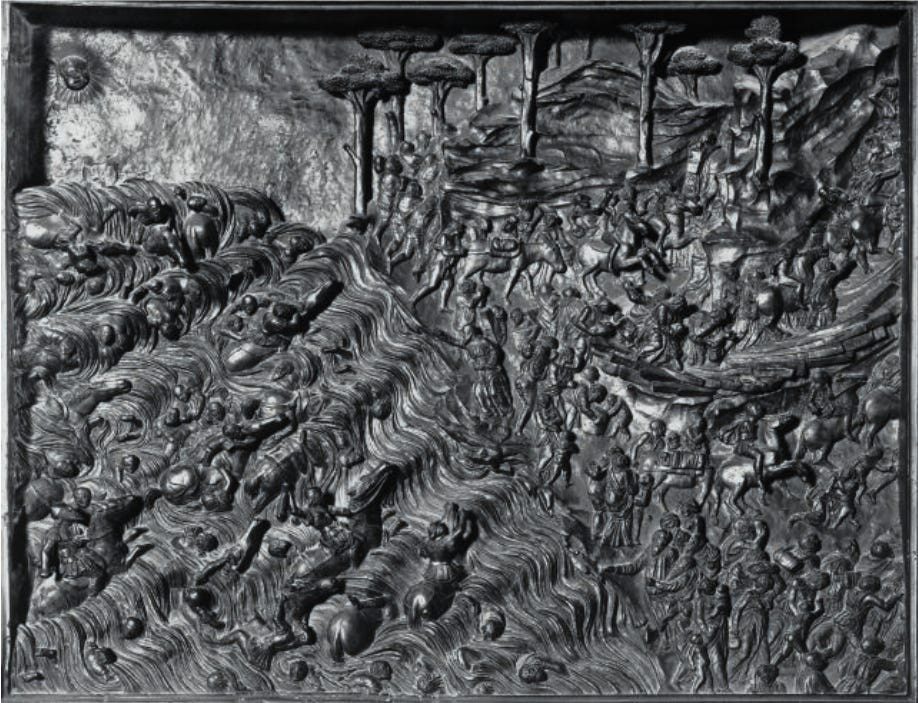Another Shot At The Hopeful Mysteries
Meditations and the second, shorter method by St. Louis de Montfort applied on another re-imagined version of the "Hopeful Mysteries", originally proposed by Fr. Mark Higgins.
When reciting the Rosary, the important and meaningful moments of salvation history are relived. The various steps of Christ's mission are traced. With Mary the heart is oriented toward the mystery of Jesus.
—Benedict XVI, address on the recitation of the Holy Rosary on May 3, 2008
I was prompted to revisit the version of the Hopeful Mysteries I posted here, after reading Fr. Mark Higgins comments on it; it caught my attention that he mentioned how he had envisioned the “Hopeful Mysteries” as preceding the Joyful Mysteries and how that shaped the set he made as well.
"Mercy is the genuine expression of life that counters death, the bitter fruit of sin. As such, it is completely lucid and in no way naïve. It is not that it is blind to evil; rather, it sees how short life is and all the good still to be done. Mercy is always tinged with hope."
—Pope Francis, meditation pronounced in the Basilica of St. John Lateran
The Hopeful Mysteries veer mostly towards the accounts after the passion and death of Our Lord on the cross — in that sense, I would place this set between the Sorrowful and Glorious Mysteries, and if I were to assign a day to it, it would be Saturday. It is analogous with the Luminous Mysteries, in that they seem to serve as prologue and epilogue to the Sorrowful Mysteries; other associations came to mind, as I remembered the 5 types of prayer laid out in the Catechism. The Prayer of Thanksgiving connects with the theme of the Mysteries of Hope, as the object (and source) of Hope itself is God’s Mercy.
The “little girl hope” is embodied in Mary, who though small and often in the darkness, was the “yes” through which God brought his greatest light into the world. She is the surprise of human history, the nobody who has been glorified, who through the grace of God brings our future hope of heaven and communion with God to us today.
—Sigurd Lefsurd, “The Hope of Mary in Spe Salvi“
The bridal theme of Saturday/Shabbat/the aftermath of The Crucifixion also compels me to associate these mysteries with the counsel of chastity, understood as the integrity that gives way to the gift of the Fear of the Lord, and very much on theme with the inclusion of the Immaculate Conception as a mystery of hope. “The Piercing of the Side of Jesus” could very well be another title for the 1st Mystery of Hope (a similar case also happens with the 1st Joyful Mystery), insofar as the “Pierced One” beholden on the cross, whose precious blood sanctifies “all stellar worlds” in time, is also the Eternal Lamb, slain before the foundation of the world, who gratuitously accords being to all of creation with his blood. The Church, represented by the Immaculate Conception, the Blessed Virgin Mary, is born at the foot of the cross from the pierced side of Jesus—and she’s equally chosen “before the foundation of the world” to be “holy and immaculate before Christ in love”.
While searching for material to expound on the Mysteries of Hope, I found a homily for Easter Vigil by John Paul II about Holy Saturday that describes, point for point and in order, each of the five mysteries I’ve assembled. The set looks like this:
1st Mystery of Hope: The Creation of All Things in Christ or The Piercing of the Side of Jesus (“…the first night, the night of Creation.”)
2nd: The Immaculate Conception (“…the second night, the night of the Exodus“)
3rd: The Burial of Christ (“You too will receive this Baptism, which brings us into a new life... This is the third night, the night of the Resurrection.“)
4th: The Descent of Christ into Hell (“…after the great silence of Holy Saturday, in which Christ… took his message of life into the pit of death, behold at last the night which precedes "the third day"…“)
5th: The Expectation of Mary (“This is the night of nights, the night of faith and of hope… O Mary, this is truly your night!“)


The first thing that stands out is that the first two mysteries are not events that fit into the chronological order between the Sorrowful and the Glorious mysteries. However, it makes sense to use them here for two reasons: first, there are not many events between the Crucifixion and the Resurrection, and last, because if we take into account the significance of Saturday in both Judaism and Catholicism, it actually makes sense to contemplate these two mysteries on Saturday. One of the things to be done on Saturday, according to Judaism, is to remember two things: the account of Creation, which colors the understanding of the 1st Mystery, remaining unchanged from the original as it appears in Fr. Mark Higgins set, and God’s redemption of Israel from slavery in Egypt, who lead His People as a Bridegroom leading His Bride, which can be seen in the chosenness of God’s people through the Blessed Virgin Mary in the 2nd Mystery, which I appears in the Bridgettine rosary as the 6th Joyful Mystery.
“Moses, Exodus 14, he freed the children of Israel from the hand of the Pharaoh, having them walk through the middle of the dry sea. . . . And all these things, and every one of them, were done by the touch of a rod received from God, for who will be this rod that allows us to cross the surging waters of this world securely, other than the blessed Virgin alone?”
—Francesco della Rovere, later Pope Sixtus IV, connecting the Immaculate Conception to the relief of the Crossing of the Red Sea sculpted by Bellano on the High Altar at the Santo in Padua.
The prohibited activities on Shabbat come from exegesis on the list of things to do in order to build the Ark of the Covenant, which in Catholicism is seen as prefiguring Mary because she bore God in her womb; a similar reflection is prompted by the 3rd Mystery of Hope, as the Empty Tomb, like the barren wombs of Sarah, Rebekah, Rachel and Hannah, is seen as a type of the Virgin Womb; it also appears in the Bridgettine rosary as the 6th Sorrowful Mystery and in the Servite rosary as the 6th and 7th mysteries. Another reason to have these mysteries here is that, after the Sorrowful Mysteries, they prompt a reflection on the work of mercy that was effected by the passion and death of Our Lord: Christ as a High Priest on the altar of the Cross, sanctifying His creation, redeeming all men and giving His Mother to us as our own. The 4th Mystery of Hope is part of the Creed and as such it can’t be omitted, and as discussions about universal salvation pop up again in the Church it is necessary to keep this mystery present, to reflect and ponder upon it and what it means for us as Christians. Along the 5th Mystery of Hope proposed here, it’s an “innovation” and doesn’t seem to appear in any rosary-based devotion.
Saturday is also associated with Mary in Catholicism, as seen in the First Saturdays devotion, and by the fact that the Feast of the Immaculate Heart of Mary is celebrated on a Saturday, after the Feast of the Sacred Heart of Jesus which falls on a Friday. In Judaism, the Shabbat is referred to as “bride” and “queen”, which are titles we use in Catholicism for the Church and Mary. There’s also the beautiful tradition of The Bridegroom Service on Holy Week; and on Holy Saturday of The Hour of the Mother, “the longest day”, in which we reflect on both Mary’s pain and expectancy of her Son, which is what glues these mysteries together. On this same day Nuestra Señora de la Esperanza (Our Lady of Hope) is also remembered (firstly, an octave before Christmas on her feast day) in Spain and other Hispanic countries who maintain this tradition, which bring both a Lent and Advent-like quality to these mysteries. Byzantine Catholics (who also pray the rosary FYI) also have a set called“mysteries of hope” — though none of these sets are “official” or mandatory, it’s always good that the Church comes up with ways to help the faithful in the task of contemplation to which we are all called to.
Praying these mysteries as shown here has been a great source of contemplation for me, perhaps in great part due to also praying the Liturgy Of The Hours — some lines and words and verses from the psalms have seeped into my mind as I prayed the rosary, which is sort of what shaped the way I employed the 2nd method of praying the rosary, devised by St. Louis de Montfort, as shown below.
Second, Shorter Method of praying the Rosary
(by St. Louis de Montfort)
Of celebrating the life, death and heavenly glory of Jesus and Mary in the Holy Rosary and a method of restraining our imagination and lessening distractions.
“To do this a word or two is added to each Hail Mary of the decade reminding us of the mystery we are celebrating. This addition follows the name of Jesus in the middle of the Hail Mary: ‘and blessed is the fruit of thy womb, Jesus, _________. Holy Mary, Mother of God…’”
1st Decade: ’Jesus, medium of all creation.’
2nd Decade: ‘Jesus, redeemer of the universe.’
3rd Decade: ‘Jesus, rest of the afflicted.’
4th Decade: ‘Jesus, liberator of the captive.’
5th Decade: ‘Jesus, our hope.’
At the end of the five mysteries we may say:
“May the grace of the hopeful mysteries come into our souls and prepare us to receive God. Amen.”





